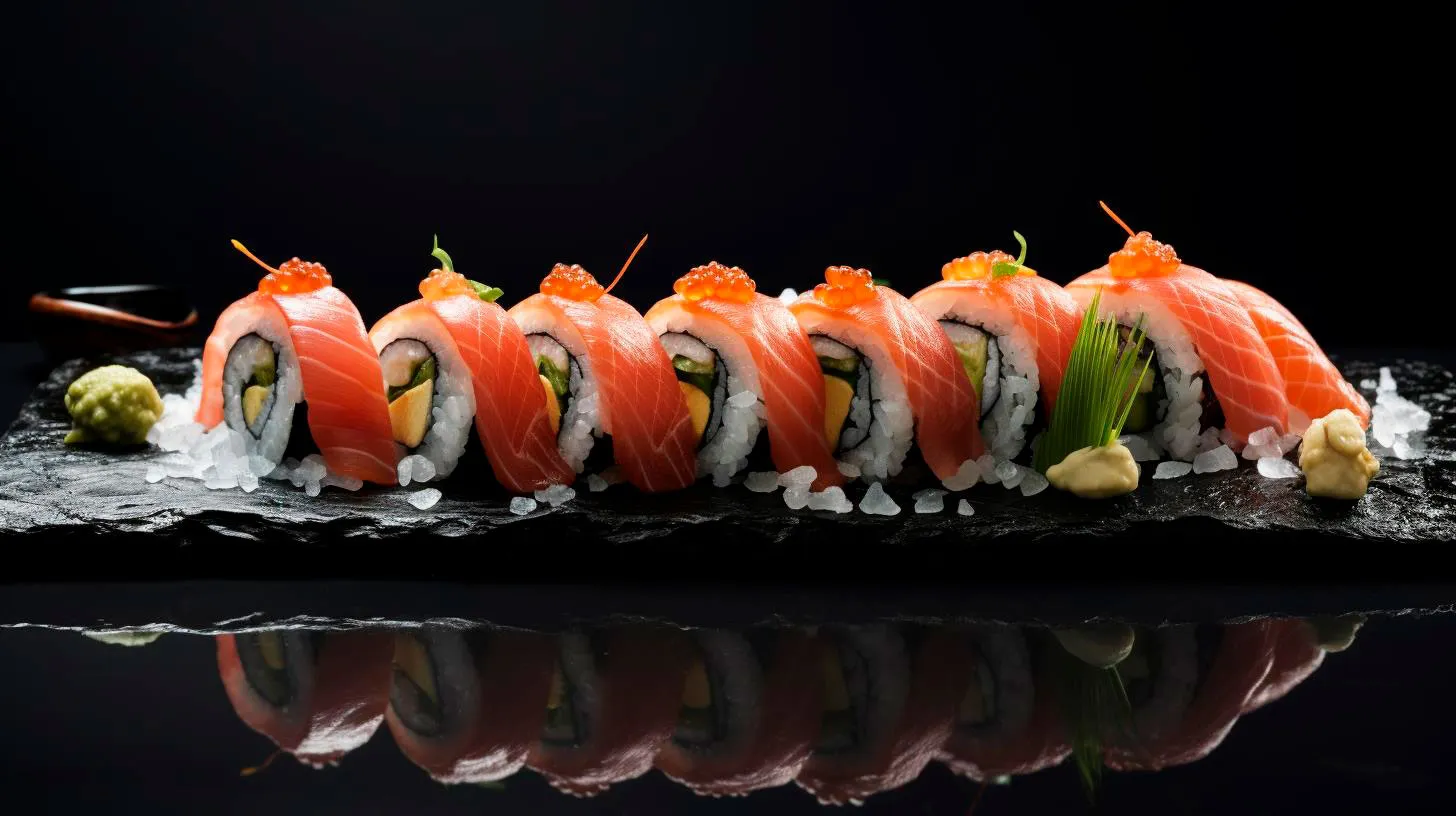Innovative Combinations Unveiling the Creative Side of Vegan Gluten-Free Sushi
Fortunately, innovative chefs and food enthusiasts have taken up the challenge of creating vegan and gluten-free versions of sushi without sacrificing taste or aesthetics. By combining plant-based ingredients and creative techniques, they have succeeded in unraveling the world of vegan gluten-free sushi, making it accessible to a wider audience.
The Rise of Vegan and Gluten-Free Sushi
As the number of people adopting vegan and gluten-free diets continues to grow, the demand for alternative food options has also increased. Restaurants and food entrepreneurs alike have recognized this shift and are striving to cater to these dietary preferences. Today, you can find a plethora of vegan and gluten-free sushi options that are not only delicious but also visually stunning.
Thanks to advancements in food technology and the availability of plant-based ingredients, chefs now have an extensive array of options to choose from. By combining these ingredients in innovative ways, they have challenged the traditional notions of sushi, creating new flavor profiles and textures that appeal to vegans, gluten-sensitive individuals, and sushi lovers alike.
Creative Combinations and Techniques
Vegan gluten-free sushi pushes the boundaries of creativity, bringing together unique combinations of ingredients, colors, and textures. Here are some of the creative techniques and ingredient combinations that have emerged:
1. Vegetable Rolls
Traditional sushi is often centered around fish and seafood. In vegan sushi, vegetables take the center stage, creating stunning rolls bursting with colors and flavors. From avocado and cucumber to sweet potato and bell peppers, the possibilities for vegetable-based rolls are endless. These vegetable rolls offer a refreshing and crunchy experience, while still providing the satisfaction that sushi brings.
2. Plant-Based Protein Fillings
For those seeking a heartier option, plant-based protein fillings are a game-changer. Ingredients like marinated tofu, tempeh, or seitan can be used as a substitute for meat or fish. These protein-packed fillings not only add a substantial element to the sushi but also enrich the overall flavor profile.
3. Creative Rice Alternatives
While traditional sushi relies on sticky rice, innovative vegan and gluten-free sushi recipes experiment with alternative grains and seeds. Quinoa, cauliflower “rice,” and even black rice can be used to add unique flavors and textures to the sushi rolls. These alternatives provide a healthier option while maintaining the essence of sushi.
4. Diverse and Vibrant Sauces
One of the hallmarks of sushi is the variety of dipping sauces that accompany it. With vegan gluten-free sushi, chefs have explored numerous options for sauces made from plant-based ingredients. From tangy mango salsa to creamy avocado sauce, these sauces add an extra burst of flavor, complementing the ingredients within the sushi rolls.
The Advantages of Vegan Gluten-Free Sushi
By embracing vegan and gluten-free sushi, individuals can experience a multitude of benefits:
- Healthier Choices: Vegan gluten-free sushi opens up a world of nutritious options, incorporating colorful vegetables and wholesome plant-based proteins into each roll.
- Allergy-Friendly: Those with gluten sensitivities or allergies can now enjoy sushi without compromising their dietary restrictions.
- Sustainable and Eco-Friendly: Plant-based sushi reduces the environmental impact associated with traditional fishing practices.
- Increased Menu Variety: Restaurants that offer vegan and gluten-free sushi attract a wider customer base, catering to diverse dietary needs.
Key Takeaways
- Vegan gluten-free sushi showcases creative combinations of plant-based ingredients and innovative techniques, bringing sushi to those with dietary restrictions.
- Vegetable rolls, plant-based protein fillings, alternative rice options, and diverse sauces are some of the emerging trends in vegan gluten-free sushi.
- Adopting vegan and gluten-free sushi opens new avenues for healthier choices, addresses dietary restrictions, promotes sustainability, and expands menu options for businesses.
With the rise of vegan and gluten-free diets, the evolution of sushi continues to surprise and delight food enthusiasts worldwide. As chefs and food entrepreneurs embrace innovation, vegan gluten-free sushi stands as a testament to the creative potential of plant-based cuisine. So, whether you’re vegan, gluten-sensitive, or simply an adventurous sushi lover, exploring the world of vegan gluten-free sushi will undoubtedly unveil a delightful and delicious experience.
The Rise of Vegan Sushi: Exploring Plant-Based Options
In this article, we will explore the growing trend of vegan sushi, its benefits, and key takeaways for sushi enthusiasts and newcomers alike.
Embracing Plant-Based Alternatives
As the vegan and vegetarian movements continue to gain momentum, individuals are seeking flavorful and innovative plant-based alternatives for their favorite dishes. Sushi is no exception. Traditional sushi ingredients, such as fish and seafood, can now be substituted with various plant-based options that provide incredible taste and texture.
Key Takeaway: Vegan sushi offers a creative and sustainable alternative for people looking to enjoy a delicious and guilt-free dining experience.
Exploring the Ingredients
Vegan sushi presents a vast array of plant-based ingredients that complement the traditional flavors of sushi. Here are a few popular plant-based ingredients used in vegan sushi:
- Vegetables: Carrots, cucumbers, avocado, bell peppers, and asparagus are commonly used to add a crunchy texture and vibrant colors to vegan sushi rolls.
- Plant-based Proteins: Ingredients such as tofu, tempeh, and seitan provide a protein-packed filling, adding depth and substance to sushi rolls.
- Mushrooms: Portobello, shiitake, and oyster mushrooms offer a meaty texture and robust umami flavor, enhancing the overall taste of vegan sushi.
Key Takeaway: Vegan sushi showcases a variety of plant-based ingredients that bring unique flavors and textures to each bite.
Health Benefits of Vegan Sushi
Aside from the environmental benefits of reducing seafood consumption, opting for vegan sushi can also provide a range of health benefits. Let’s take a closer look:
- Heart-Healthy: Plant-based ingredients used in vegan sushi are low in cholesterol and saturated fats, which can benefit heart health and reduce the risk of cardiovascular diseases.
- Rich in Fiber and Vitamins: Vegetables and plant-based proteins used in vegan sushi are excellent sources of fiber and essential vitamins, promoting digestion and overall well-being.
- Lower in Mercury: By replacing fish and seafood with plant-based alternatives, vegan sushi eliminates the risk of mercury contamination, making it a safer option for consumption.
Key Takeaway: Vegan sushi not only fulfills your sushi cravings but also offers a healthier alternative that supports overall well-being.
Environmental Impact
With sustainability becoming a significant concern globally, vegan sushi addresses the environmental impact of traditional sushi. Consider the following:
- Overfishing Concerns: The demand for seafood used in sushi has led to overfishing, which harms marine ecosystems and depletes natural resources. Vegan sushi helps alleviate the pressure on marine life.
- Reduced Carbon Footprint: The production of plant-based ingredients for vegan sushi generates fewer greenhouse gas emissions compared to the fishing industry. Opting for vegan sushi contributes to the reduction of carbon footprint.
Key Takeaway: By choosing vegan sushi, you actively engage in sustainable practices, supporting the conservation of marine life and reducing your ecological footprint.
Culinary Creativity
Vegan sushi has provided chefs and home cooks with the opportunity to showcase their culinary creativity by experimenting with various plant-based ingredients. With an endless combination of flavors and textures, vegan sushi offers a wide range of exciting options for sushi enthusiasts.
Key Takeaway: Vegan sushi allows chefs and home cooks to explore a world of innovative recipes and create unique flavor profiles that cater to diverse palates.
Conclusion
The rise of vegan sushi is an exciting development in the world of dining. With its wide range of plant-based ingredients, health benefits, and positive impact on the environment, vegan sushi offers a delicious and sustainable alternative to traditional sushi. Embrace the culinary creativity and flavors of vegan sushi, and embark on a flavorful journey that supports your well-being and the planet.
Healthy and Delicious: Discovering the Flavors of Veggie Sushi
In this article, we will explore the world of veggie sushi, its health benefits, and even provide some unique and tasty recipes to try at home. Are you ready to embark on a culinary adventure? Let’s dive in!
The Health Benefits of Veggie Sushi
Veggie sushi is not only a mouthwatering delight but also a fantastic option for health-conscious individuals. Here are some health benefits of incorporating veggie sushi into your diet:
- Rich in Nutrients: Veggie sushi is packed with essential vitamins, minerals, and dietary fiber.
- Reduced Mercury Intake: Compared to seafood-based sushi, veggie sushi eliminates the risk of mercury consumption.
- Heart-Healthy: The omega-3 fatty acids found in seaweed used in veggie sushi can help lower cholesterol levels.
- Weight Management: With its low-calorie content, veggie sushi can be a great addition to a balanced diet for those aiming to lose or maintain weight.
Unique and Exciting Veggie Sushi Recipes
Ready to roll up your sleeves and create your own veggie sushi masterpiece? Here are a few delicious recipes to get you started:
1. Avocado and Cucumber Roll
Ingredients:
- Sushi rice
- Nori seaweed sheets
- Avocado
- Cucumber
- Soy sauce for dipping
How to make it:
- Prepare sushi rice according to package instructions.
- Place a sheet of nori seaweed on a rolling mat.
- Spread a thin layer of sushi rice onto the nori, leaving a small border at the top edge.
- Place sliced avocado and cucumber in a line across the middle of the rice.
- Gently roll the mat, applying pressure to create a tight roll.
- Allow the roll to rest for a few minutes before slicing it into bite-sized pieces.
- Enjoy your avocado and cucumber roll with soy sauce for dipping!
2. Sweet Potato Tempura Roll
Ingredients:
- Sushi rice
- Nori seaweed sheets
- Sweet potato
- Tempura batter mix
- Vegetable oil for frying
How to make it:
- Cook sushi rice according to package instructions.
- Prepare tempura batter by following the instructions on the pack.
- Peel and slice the sweet potato into thin strips.
- Dip the sweet potato slices into the tempura batter and deep fry until golden brown.
- Place a sheet of nori seaweed on a rolling mat and spread sushi rice evenly.
- Arrange the sweet potato tempura slices along the middle of the rice.
- Roll the mat tightly, ensuring the filling is enclosed within the nori and rice.
- Allow the roll to rest for a few minutes before slicing.
- Indulge in the delightful crunch of your sweet potato tempura roll!
Remember, these recipes are just a starting point. Feel free to experiment with various vegetables, fruits, and condiments to create your own unique veggie sushi rolls!
Key Takeaways
Veggie sushi offers a tantalizing and healthy alternative to traditional seafood-based rolls. By incorporating veggie sushi into your diet, you can enjoy various health benefits, including increased nutrient intake, reduced mercury consumption, and support for heart health. Additionally, preparing your own veggie sushi allows you to explore creative flavor combinations and tailor the rolls to your preferences. So why not embark on a culinary adventure and discover the enticing flavors of veggie sushi? Your taste buds and your body will thank you!
Gluten-Free Sushi: A Delight for Celiac Dieters
The good news is that gluten-free sushi options cater to the needs of celiac dieters, allowing them to savor this delicious creation without any worries.
The Rise of Gluten-Free Sushi
Gluten-free diets have gained significant traction over the years, with more and more people realizing the impact gluten can have on their overall health. As a result, the demand for gluten-free alternatives has skyrocketed, prompting the food industry to adapt and create options suitable for different dietary needs.
When it comes to sushi, the traditional ingredient that contains gluten is soy sauce, commonly used as a dipping sauce. However, with the rise of gluten-free awareness, many sushi chefs have started incorporating gluten-free tamari sauce, which is made without wheat, into their recipes.
Features and Benefits of Gluten-Free Sushi:
- Safe for Celiac Dieters: Gluten-free sushi provides a safe option for individuals with celiac disease or gluten intolerance, allowing them to enjoy a popular and beloved cuisine.
- Wide Variety: Gluten-free sushi is not limited to just one or two options. Sushi restaurants and chefs have embraced this trend by offering a wide range of gluten-free rolls and nigiri, ensuring there is something for every palate.
- Flavorful and Fresh: Gluten-free sushi maintains the same level of flavor and freshness as traditional sushi. It combines high-quality ingredients and expert craftsmanship to create delectable rolls that are just as enjoyable.
- Healthy Alternative: Gluten-free sushi is often made with nutrient-rich ingredients like fresh fish, vegetables, and seaweed, making it a healthy choice for individuals looking to improve their diet.
- Improved Digestion: Going gluten-free can relieve digestive issues in individuals who are sensitive to gluten, promoting better overall gut health.
The Importance of Gluten-Free Menus
In recent years, restaurants across the globe have responded to the growing demand for gluten-free options by introducing dedicated menus that cater to dietary restrictions. Including gluten-free sushi on these menus not only expands the range of choices for customers but also highlights the establishment’s commitment to accommodating various needs.
The availability of gluten-free menus can significantly impact diners’ perception of an establishment’s dedication to customer satisfaction. It creates a positive experience that goes beyond the meal itself, increasing customer loyalty and attracting new patrons.
Key Takeaways:
- Gluten-free sushi caters to individuals with celiac disease or gluten sensitivity, providing a safe and enjoyable dining experience.
- Restaurants offering gluten-free menus showcase their commitment to customer satisfaction and attract a wider range of diners.
- Gluten-free sushi is a flavorful and healthy alternative, with a variety of options to suit different tastes.
- Gluten-free diets can lead to improved digestion and overall gut health for individuals sensitive to gluten.
As the awareness of gluten-related issues continues to grow, the presence of gluten-free sushi on menus around the world is becoming more prevalent. Offering a wide range of delicious options, this gluten-free twist on a beloved culinary tradition allows everyone, including celiac dieters, to join in and relish the joy of sushi without compromise.


